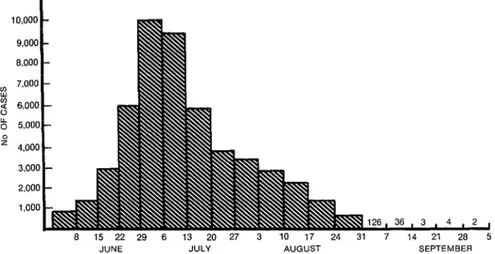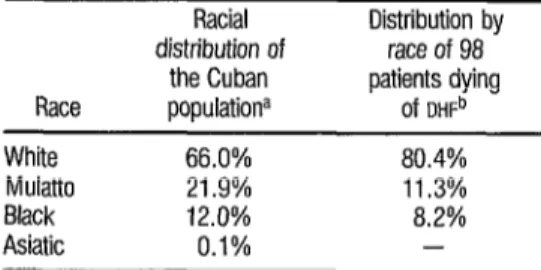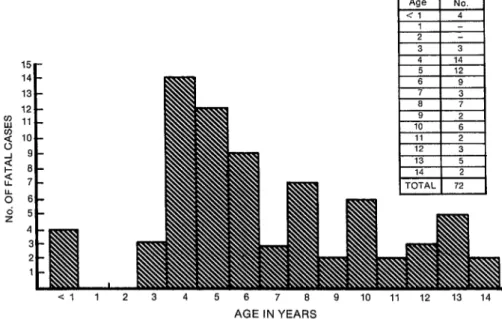HE
MORRHAGIC
DENGUE IN CUBA: HISTORY OF
AN EPIDEMIC1
GzGstavo Koz~ti,~ Mati G. Guzrnh~,~ and Jo& Bravo4
T
Dengue hemorrhagic fever
(DHF), first described in 1957 by Ham- mon in the Philippines (I), causes high morbidity and mortality in some parts of the world (2) and constitutes a significant threat to public health. Until 1981, this disease had been limited to Southeast Asia and the Western Pacific. No epi- demics Of DHF had occurred in the Amer- icas, despite circulation of dengue viruses in our Region for the previous 25 years or so (3, 4), and only sporadic cases had been reported in that period (5, G).
In the summer of 1781, how- ever, Cuba was struck by a major dengue epidemic that included numerous DHF
cases and fatalities. This constituted the first time in this century that confirmed
DHF cases had occurred in the Americas and one of the few occasions on which
DHF had been detected outside of South- east Asia and the Western Pacific (7), Previously published articles have dealt with various aspects of this epidemic (S-
I This article will also be published in Spanish in the Bo- let% de la 0$&a Sanitaria Panamericana.
* Virologist; Director, Pedro Kouri Institute of Tropical Medicine, Havana, Cuba.
3 Chief, Department of Virology, Pedro Koud Institute. 4 Biostatistician, Department of Virology, Pedro Koud
Institute.
I.?), but none has described the principal indicators detected during the outbreak or their evolution, which is the purpose of this report.
Within this context, it should be mentioned that the DHF epidemic in Cuba merits thorough study, because it offers a unique opportunity to augment our theoretical and practical knowledge of the disease.
ously-a state of affairs creating obvious difficulties for data interpretation.
PORT ON
THE EPIDEMIC
Early Developments
The epidemic was first de- tected in late May 198 1, several weeks af- ter the onset of the rainy season, on the outskirts of the city of Havana, where a growing number of people were coming down with fever; abdominal, retroocu- lar, and muscular pains; intense head- ache and asthenia; rashes; and occasion- ally a hemorrhagic picture accompanied by shock that in some cases led to death. At the time the epidemic was recog- nized, high indexes of Aedes aegypti in- festation existed in almost all the coun- try’s urban centers.
The first cases were deemed to be meningococcemia, partly because this disease is endemic in Cuba, and partly because there were no previously re- ported cases of DHF in our country. How- ever, these first cases were quickly fol- lowed by an explosive epidemic, with cases being reported throughout the is- land.
At this time the Pedro Kouri Institute of Tropical Medicine was asked to diagnose the illness and identify the virus. Within 24 hours the health au- thorities were presented with a presump- tive seroepidemiologic diagnosis, and a few days later the dengue-2 virus was iso- lated and identified, using a methodol- ogy previously described (8).
Clinical Symptoms
The clinical picture of typical
DHF cases was characterized by fever, vomiting, hepatomegaly, and abdominal
pains. The hemorrhagic manifestations most common in children were petechiae and hematemesis, while those most com- mon in adults were purpura, metrorrha- gia (in women), and hematemesis. Shock, when it developed, occurred most frequently on the fourth day of clinical symptoms. Among the children who died, hemorrhaging predominated; while among the adults who died, shock predominated.
An interesting fact about the disease in adults is that even though the course of the disease was generally favor- able and few cases of shock were ob- served, when shock was present the evo- lution was almost invariably fatal. In contrast, children with the disease who exhibited shock more commonly recov- ered, a circumstance that could indicate an important difference between chil- dren and adults regarding the mecha- nisms that produce shock.
Morbidity
Figure 1 shows the numbers
of dengue cases recorded over the course s of the epidemic. In all, 344,203 cases 2 were registered and reported (on a daily
basis) to the Ministry of Public Health. s The week of highest incidence extended 3 from 30 June through 6 July, when a 2 daily average of 9,447 cases was reported; 3 and the day of highest incidence was 6 July, when 11,400 cases were reported. s
A gradual decline in morbid- 5 ity that began the second week in July 3 was due, in our opinion, to an intense
anti-Aedes campaign that was launched s 3 . 4; b
P ‘fit g k
26
a 15 22 29 6 13 20 27 3 10 17 24 31 7 14 21 28 5 JUNE JULY AUGUST SEPTEMBER
FIGURE 1. A weekly record of the average daily numbers of dengue cases reported between 1 June and 5 October during Cuba’s 1981 epidemic.
across the country in the month of June, producing a rapid drop in the indexes of vector infestation.
Overall, the epidemic lasted from the end of the month of May until
10 October, when the last case was re- ported. Around the latter time a na- tional dengue surveillance system was es- tablished that is still in existence; after more than three years of operation, it al- lows us to affirm that the country is en- tirely free of this disease.
Hospitalizations and Case Severity
Table 1 shows the number of dengue patients hospitalized during each month of the epidemic. As may be seen, the Ministry of Public Health adopted a liberal hospital admission pol- icy for dengue cases, with the result that 116,151 patients (33.7% of all those with reported cases) were admitted. This policy appears to have played a signifi- cant role in reducing fatalities; in other epidemics elsewhere, where the index of hospitalization was typically much lower,
TABLE 1. The numbers of people hospitalized for dengue during the 1981 dengue epidemic in Cuba, by month.
Month No. hospitalized June 16,302 July 51,813 August 46,455 September 1,499 October 62 Total 116,151
TABLE 2. Numbers of cases classified as “serious” or “very serious” in a manner corresponding to levels Ill and IV, respectively, in the classification established by the
WHO Technical Advisory Committee on DHF for the South Asian and Western Pacific regions (If?)), by month.
Month
Serious cases
Very serious
cases Total June 1,660 221 1,881 July 5,508 715 6,223
August 1,949 171 2,120
September 85 2 a7
October 1 - 1 Total 9,203 1,109 10,312
in the classification established by the World Health Organization Committee of Experts for Hemorrhagic Dengue in Southeast Asia and the Western Pacific
(1G). As may be seen, a total of 9,203 se- rious cases and 1,109 very serious cases were recorded, with the highest numbers of both types occurring in July.
TABLE 3. Distribution by race of 98 patients (72 children and 26 adults) dying of DHF in the 1981 epidemic.
Race White Mulatto Black Asiatic
Racial Distribution by distribution of race of 98
the Cuban patients dying populationa Of DHFb
66.0% 80.4%
21.9% 11.3%
12.0% 8.2%
0.1% -
a This racial distribution, found by the NatIonal Housmg and Population Census of 1980, was based on skin color.
b The race of each of the 98 patients, obtained from the patlent’s chmcal hIstory. was likewise determined according to skin color
M
OR’IXLI’I’Y
PA3YlTaNS
A total of 158 deaths were re- ported, yielding an overall mortality of
1.59 deaths per 100,000 inhabitants and a lethality index (deaths per 1,000 den- gue cases) of 0.46, the lowest lethality in- dex reported until then for a dengue epi- demic involving confirmed DHF. The ages of the patients who died ranged from three days to 80 years, the modal age being four years. In all, 101 children and 57 adults died. The high proportion of adult deaths deserves particular atten- tion, because DHF morbidity and mortal- ity among adults is uncommon in South- east Asia and the islands of the Western Pacific.
Table 3 shows the distribution by race of the 98 fatalities for whom clin- ical histories were available. These fig- ures appear to indicate that there was a statistically significant (p < 0.05) pre- dominance of fatalities among whites, relative to the proportion of whites within the Cuban population. To date, no explanation for this observation has been found.
Regarding the sex of those fa- tally afflicted, no significant female pre- dominance was evident-an observation that contrasts with reports from countries where DHF is endemic (2). However, data on serious and fatal cases among both children and adults indicated that cer- tain inherited or partly inheritable condi- tions-including asthma, diabetes, and sickle cell anemia-constituted risk fac- tors for both serious disease and death from DHE
Another interesting point is brought out by considering the specific ages of the 72 children who died of DHF.
As Figure 2 shows, no recorded deaths occurred among children one or two
AGE IN YEARS
FIGURE 2. The age in years of 72 children who died of dengUe hemorrhagic fever dUring Cuba’s 1981 epidemic.
born at the time of the 1977 dengue-1 epidemic and so would not have been in- fected by the dengue- 1 virus. In other words, for these children a dengue-2 in- fection would not have constituted a sec- ondary infection with a new dengue virus serotype. This observation provides sub- stantial support for Halstead’s view that
DHF can result if a person previously in- fected with dengue experiences a second infection with another dengue virus sero- type (17). In this regard, it should also be noted that it was very uncommon to find any children in this age range with seri- ous cases who had obvious DHF symp- toms. It is true (as Figure 2 indicates) that four infants (children under one year old) died of DHF; but in this instance ma- ternal antibodies to prior dengue infec- tion could have created an immunologic situation similar to that produced by pre- vious primary infection of the infant with dengue- 1.
C
ONCLUDING
REMARKS
In summing up, it seems ap- propriate to direct attention to a number of basic findings relating to the Cuban epidemic that could prove useful in in- terpreting epidemiologic data from other countries. These findings are as follows:
l Epidemic hemorrhagic den-
gue can occur under the ecologic condi- tions prevailing in the Caribbean.
l The Cuban epidemic broke
out suddenly, soon after the beginning of the rainy season.
l Heavy infestation with an
efficient mosquito vector ( Aedes aegyp- tz) was a necessary factor in making the epidemic possible.
l The Cuban population had
little protection against the dengue vi- ruses involved.
l The sequence of viruses
was dengue-1 (in 1977) and dengue-2 (in 1981).
l The interval between the
first and second dengue infections was about three years.
l Hemorrhagic dengue was
found to occur among both children and adults, depending on their immunologic status.
l Hemorrhagic dengue was
found to occur among whites, blacks, and mulattoes, although the serious and fatal cases appeared to occur predomi- nantly among whites.
l Both dengue-1 in 1977 and
dengue-2 in 1981 caused large numbers of disease cases, and in 198 1 these cases were concentrated within less than a four-month span of time. These observa- tions point to widespread and rapid den- gue virus circulation during both of these epidemics.
A
CKNOWLEDGMENT
The studies reported here constitute part of a dengue hemorrhagic fever research program developed by the Pedro Kouri Institute of Tropical Medi- cine in Havana with the financial sup- port of the International Development and Research Center in Ottawa, Canada.
S
UMMARY
The dengue epidemic that struck Cuba in 1981 deserves special at- tention. Quite aside from the fact that it caused over 300,000 cases of dengue, this epidemic was the only one in the history of the Americas to cause numerous con- firmed cases of dengue hemorrhagic fe- ver (DHF) and shock syndrome, a devel- opment leading to 158 recorded deaths. It was also the only major epidemic in-
volving DHF known to have occurred away from areas where viruses belonging to all four dengue serotypes were in si- multaneous circulation, and so it has af- forded a unique opportunity to study hemorrhagic dengue in well-defined epi- demiologic circumstances where the cir- culation of multiple dengue virus sero- types has not impeded interpretation of the data.
Some of the points about this epidemic tthat seem especially notewor- thy are as follows: An unusually large proportion of those dying (36%) were over 15 years of age. Hemorrhagic symp- toms in children most often took the form of petechiae and hematemesis, while in adults they most often took the form of purpura, metrorrhagia (in women), and hematemesis. Not many cases of shock were observed among adults, but those that occurred were al- most invariably fatal.
RE
FERENCES
1 Hammon, W. McD., A. Rudnick, G. F. Sather, K. D. Rogers, V. Chan, J. J. Dizon, and D. Basaka-Sevilla. Studies on Philippine Hemorrhagic Fever: Relationship to Dengue Viruses. Proceedings of the Ninth PaGifc Sci- e&z@ Congress. Bangkok, Thailand, 1957, pp. 67-72.
2 Halstead, S. B. Dengue haemorrhagic fever- a public health roblem and a field for re- search. Bzd’l W 0 58:1-21. 1980. HP
3 Anderson, C. R., W. G. Downs, and A. E. Hill. Isolation of dengue virus from a human being in Trinidad. Science 124:224-225, 1956.
4 Russell, P. K., E. L. Buescher, J. M. McCown, and J. Ordonez. Recovery of dengue viruses from patients during epidemics in Puerto Rico and East Pakistan. Am J Trop Med Hyg 15:573-579, 1966.
5 Fraser, H. S., W. A. Wilson, E. Rose, E. J. Thomas, and J. G. P. Sissons. Dengue fever in Jamaica with shock and hypocomplemen-
taemia, haemorrhagic visceral and neurologi- cal comnhcations. West Indian Med I 27: 106-
116, 19%. * Lopez-Correa, R. H., B. L. Cline, C. Ramirez Ronda, R. Bermudet, G. E. Sather, and G. Kuno. Dengue fever with hemorrhagic mani- festations: A report of three cases from Puerto Rico. Am J Eop Med Hyg 27:1216-1224,
1978.
Halstead, S. B., and G. Papaevangelou. Trans- mission of dengue 1 and 2 viruses in Greece in 1928. Am J pop MedHyg 291635-637, 1980. Kouri, G., P. Mh, M. G. Guzman, M. Soler, A. Goyenechea, and L. Morier. Dengue hem- orrhagic fever in Cuba, 198 1: Rapid diagnosis of the epidemiologic agent. BULL Of Sanit Panam 17(2):126-132, 1982.
Guzman, M. G., G. Kouri, J. Bravo, M. Soler, S. Vat uez
rhagrc ever m Cuba: I. Serological confirma- .4 ‘. and C. Venereo. Dengue hemor- tion of clinical diagnosis. l?ans R SOG Fop MedHyg 78:235-238, 1984.
10
11
12
13
14
15
16
17
Guzman, M. G., G. Kouri, J. Bravo, M. Soler, M. Santos, R. Villaescusa, P. Basanta, G. In- dan, and I. M. Ballester. Densrue hemorrhaeic fever in C\ba: II. Clinical inv&tigations. Z&zs R Sot Fop MedHyg 78:239-241, 1984. Guzman, M. G., G. Kouri, L. Morier, M. So- ler, and A. Fernandet. Casos mortales de den- gue hemorragico en Cuba, 1981. Bol Of Sanit Panam 97:111-117, 1984.
Guzmbn, M. G., G. Kouri, M. Soler, L. Mo- rier, and S. Vazquez. Aislamiento de1 virus dengue 2 en sueros de pacientes utilizando el rat& lactante y cultivo de &l&s LLCMK2. Rev Cab Med i?op 36:4-10, 1984.
Pittaluga, G. Sobre un brote de “dengue” en la Habana. Revisita de Medicina Tropical y Parasitol’ogia, BacteriologZa, Clinica y Labora- tonb ll:l-3, 1945.
Mk, I? Dengue fever in Cuba in 1977: Some laboratory aspects. In: Pan American Health Organization. Den ne in the Caribbean, 1977. PAHO Scient rc Publication 375. Wash- $ ington, D.C., 1979, pp. 40-43.
Schlesinger, R. W. Dengue V&es. Virology Monographs, No. 16. Springer-Verlag, Wien- New York, 1977, p. 94.
World Health Organization, Technical Advi- sory Committee on Dengue Hemorrhagic Fe- ver for the South Asian and Western Pacific Regions. Guide for Diagnosis, Treatment and Control of Dengzce Hemorrhagic Fever (Sec- onded.). Geneva, 1980, p. 80.


